The most efficient workout and the most versatile tool for shoulder workout is bodyweight.
Bodyweight exercises can strengthen and stabilise your shoulders at home without the need for machines, dumbbells, or barbells.
The beauty of bodyweight training is that it’s the original way humans got strong, long before gyms existed.
With the appropriate exercise, progressions, and a touch of creativity, your shoulder muscles can be transformed beyond your expectations.
In this blog post, we’ll show you the best bodyweight exercises that target all heads of the shoulders from multiple angles.
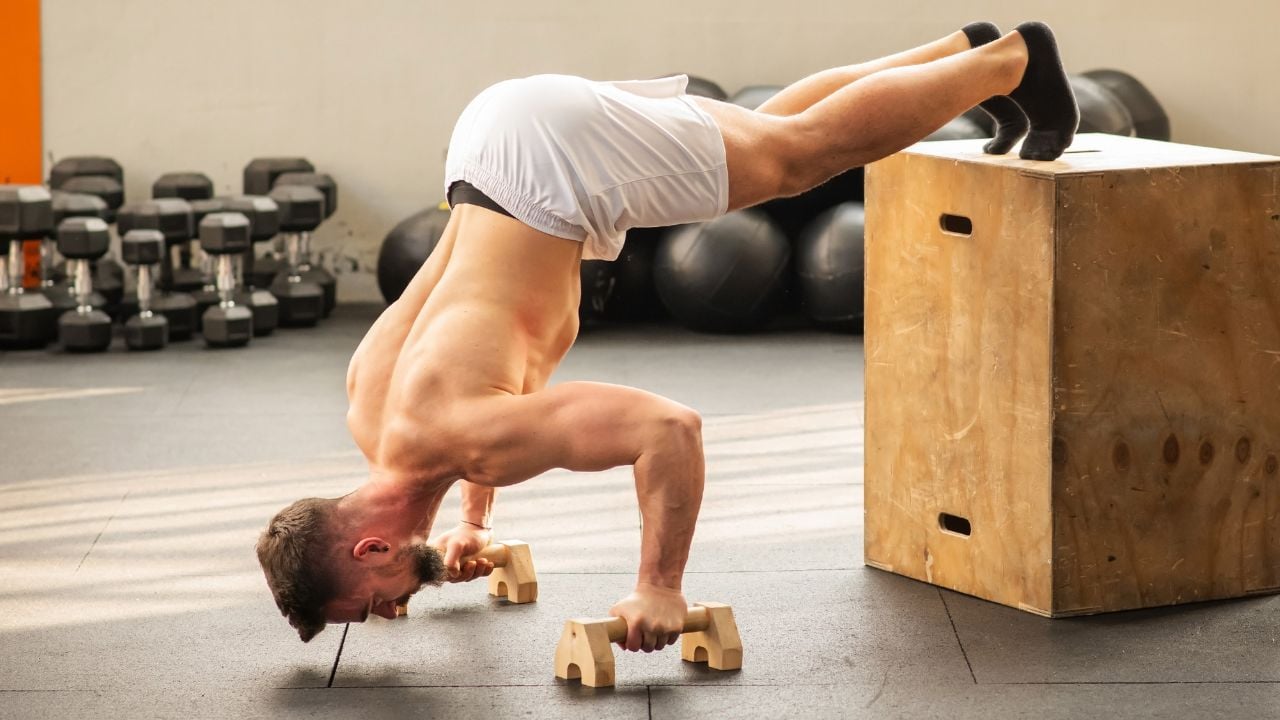
- At-Home Bodyweight Shoulder Exercises
- 1. Arm Circles
- 2. Push Ups
- 3. Side Plank
- 4. I, Y, T, W
- 5. Plank To Push Up
- 6. Plank to Downward Dog
- 7. Bear Crawls
- 8. Pike Push Up
- 9. Wall Walks
- 10. Crab Walk
- 11. Hindu Push Up
- 12. Inverted Row
- 13. Clapping push-up
- 14. Elevated pike push-up
- 15. Handstand Push Up
- Know About Shoulder Muscles
- Deltoids
- Rotator cuff
- Trapezius
- Beginner Bodyweight Shoulder Workout Plan
- Intermediate Bodyweight Shoulder Workout Plan
- Advanced Workout Plan
- Takeaways
- References
At-Home Bodyweight Shoulder Exercises
Here are some examples of beginner bodyweight shoulder exercises:
1. Arm Circles
An arm circle is the circumduction of the glenohumeral (shoulder) joint. This means the humerus (upper arm bone) moves through a conical path, combining flexion, extension, abduction, and adduction in a fluid, circular motion.
This circular motion gently stretches and loosens the shoulder joints and surrounding muscles, enhancing range of motion.
The movement helps lubricate the shoulder joints, tendons, and ligaments, lowering the risk of pain or injury during other physical activities.
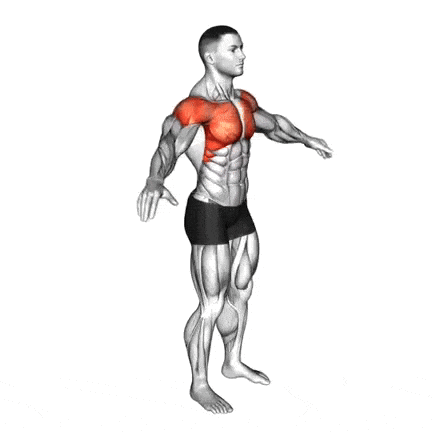
How to Do
- Stand tall, feet shoulder-width apart, with a slight knee bend.
- Extend both arms out to your sides at shoulder height.
- Start with small, controlled circles, about the size of a dinner plate, and gradually increase the size.
- After 20–30 seconds, reverse the direction (backwards).
- Keep your shoulders relaxed and core slightly engaged.
- Breathe naturally and avoid shrugging.
2. Push Ups
The standard floor push-up is a gold-standard bodyweight exercise, revered for its simplicity yet profound in its ability to build upper body strength, core stability, and overall bodily control.
It recruits the chest, shoulders, and triceps while engaging stabilizers like the biceps, upper back, and abdominals for posture and balance
If you are new to push-ups, have shoulder or wrist pain, or want a gentler exercise, incline push-ups are the best choice to safely build shoulder strength and stability
It will be 50% easier to do push-ups if your feet are below your head and your body is tilted 45 degrees.
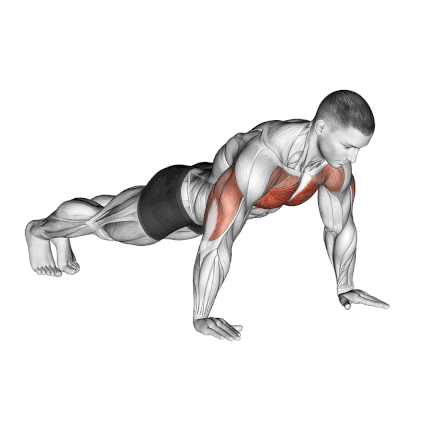
How to do
- Start in a high plank position with your hands slightly wider than shoulder-width apart.
- Engage your core, squeeze your glutes, and maintain a neutral spine.
- Lower your body towards the ground by bending your elbows while keeping them close to your sides.
- Pause for a moment at the bottom position.
- Return to the starting position by pushing through your palms and straightening your arms.
3. Side Plank
Side Plank is generally very good for the shoulder, specifically for building stability, endurance, and isometric strength in the supporting shoulder complex.
The deltoids, particularly the lateral and anterior heads, work isometrically to support the weight of the upper body and maintain the arm’s position
Additionally, side planks are frequently included in rehabilitation and strength programs to enhance shoulder function and prevent injuries

How To Do
- Place your feet together and your legs straight on the ground. This is the start of a side plank.
- Prop yourself up on your elbow and forearm, and raise your hips off the ground.
- Your body should be in a straight line from your head to your feet.
- Hold this position for a specific time (10–30 seconds) as per your comfort and repeat the same for the other side.
4. I, Y, T, W
I, Y, T, W exercises are generally EXCELLENT for shoulder health, particularly for targeting the scapula (shoulder blade), rotator cuff trapezius, and rhomboid.
I, Y, T, W exercises help stabilize the shoulder joint by strengthening the muscles that control the position and movement of the scapula.
Each letter position emphasizes different muscles:
- I: Focuses on lower trapezius and latissimus dorsi.
- Y: Targets lower trapezius and serratus anterior.
- T: Emphasizes middle trapezius and rhomboids.
- W: Engages middle/lower trapezius and external rotators
How To Do
- Lay with your stomach flat on the ground with your arms and legs fully extended.
- Point your toes away from your body and fully extend your elbows and fingers, positioning your palms facing inwards.
- Brace your abdominal muscles to stabilize your spine, depress and retract your scapulae (pull shoulders back and down).
- Attempt to hold these positions (I, Y, T, W) throughout the exercise.
- Try holding for only 5 or 10 seconds for the first time, and work up to 30 seconds in future workouts.
- Align your head with your thoracic (upper) spine.
- To increase the difficulty for either version, add a 1-3 pound weight in each hand.
5. Plank To Push Up
The Plank push—up, also known as the “plank-to-pushup,” is a combination of the two exercises (Plank and Push-up) that provides the benefits of both.
This exercise requires your shoulders-especially the anterior deltoids-to actively stabilize and support your body as you transition between the forearm plank and push-up positions.
The movement challenges both strength and control, recruiting not just the deltoids but also the supporting muscles around the shoulder joint.
How To Do
- Start in a plank position with your hands placed directly under your shoulders and your feet together.
- Use an exercise mat under your arms to increase comfort and stability.
- Keep your core tight and maintain a straight line from your head to your heels.
- From the plank position, lower yourself down into a push-up by bending your arms.
- Keep your body in a straight line and avoid sagging your hips or lifting your back.
- Push yourself back up to the starting position, fully extending your arms.
6. Plank to Downward Dog
The plank pike is an effective exercise that develops shoulder strength and core stability while increasing stability and mobility throughout the spine and hip region.
It is a more advanced variation of the plank exercise and requires a good level of core and shoulder stability.
You should include this exercise in your shoulder workout routine.
How To Do
- start in a plank position with your hands placed directly under your shoulders and your feet together.
- Keep your core tight and maintain a straight line from your head to your heels.
- From the plank position, raise your hips towards the ceiling by keeping your hands and feet in place.
- The movement should resemble an inverted V shape.
- Slowly lower your hips back down to the starting position.
7. Bear Crawls
Bear crawls are very good for the shoulders. This exercise actively engages the shoulder muscles, including the deltoids, upper trapezius, and serratus anterior, to stabilize and support the upper body while moving.
A 2021 study comparing muscle activity during bear crawls found significantly high activation of the serratus anterior and upper trapezius muscles, indicating that bear crawls effectively target key shoulder stabilizers.
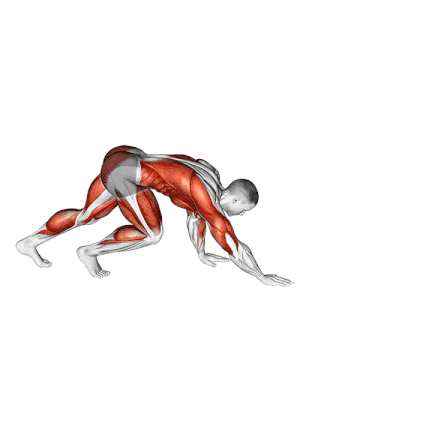
How To Do
- Start on all fours with your hands under shoulders and knees under hips.
- Spread your fingers wide, ‘grip’ the floor like you’re trying to palm a basketball.
- Tuck your toes under, then lift your knees just an inch or two off the floor. No higher. This is the most common error – hips too high.
- Move your opposite hand and opposite foot forward simultaneously and the same small distance.” (e.g., right hand, left foot). This contralateral pattern is essential.
- Think small, controlled steps. Quality over quantity or speed. Imagine a glass of water on your lower back—you shouldn’t spill it as you crawl.
8. Pike Push Up
Pike Push-ups are a variation of the push-up that increases strength and stability in the shoulders and triceps.
The hands are approximately 1-1.5x shoulder width, and the head is in line with a neutral spine.
Pike push up is a fairly advanced movement that requires extra attention to form and quality over quantity.
It is important to have enough general mobility before attempting any exercise, and beginners should start with classic push-ups before transitioning to pike push-ups.
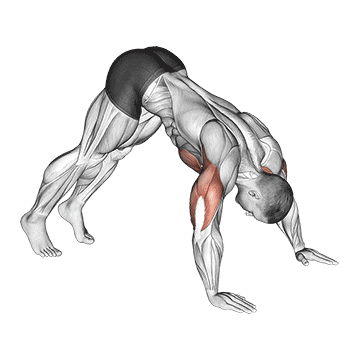
How To Do
- Start in a standard push-up position with your hands slightly wider than shoulder-width apart and elbows completely locked out.
- Lift the hips up and back until your body forms an inverted V shape.
- Keep your arms and legs as straight as you possibly can.
- Slowly lower the top of your head towards the ground.
- Once your head is about to contact the ground, pause for a second.
- Never let your head touch the floor, but try to get as close to it as you can.
- Then slowly push back until your arms are straight, and you’re in the inverted V position.
9. Wall Walks
The Wall Walk, also called the Wall Climb, is a bodyweight workout that works all your body parts. It helps you build strength, stability, and coordination in your upper and lower bodies. This dual demand improves neuromuscular coordination and enhances body awareness and control.
Wall climbs work several muscles in the upper body, including the shoulders, chest, triceps, and upper back, as well as the core muscles, including the abs and lower back.
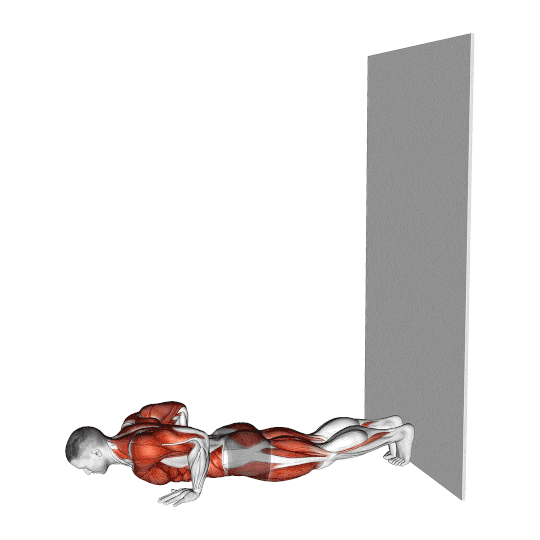
How To Do
- Start in a high plank position with your feet against the wall and your hands shoulder-width apart on the floor.
- Press your toes into the wall, lifting one foot at a time to place them against it.
- Engage your core and stabilize your upper body to prepare for the climb.
- Slowly start to “walk” your feet up the wall while moving your hands toward the wall as well.
- Keep your body straight as possible, engage your core, and maintain a tight line from head to toe.
- Once your feet are up the wall and your hands are close to it, you should be in a handstand-like position.
- Pause for a moment to stabilize your position.
- Start walking your feet back down the wall, while simultaneously moving your hands away from the wall.
- Take your feet off the wall and return to the starting plank position.
- The above will complete 1 repetition of a wall climb.
10. Crab Walk
The Crab walk is an excellent bodyweight exercise that particularly works the upper arms, shoulders, legs, and core.
It is excellent for toning, effectively targeting all your muscle groups and working them difficult to build strength.
Moves like the crab walk are great total-body exercises that require no additional equipment. They are ideal when you don’t have a lot of time or fitness gear on hand.
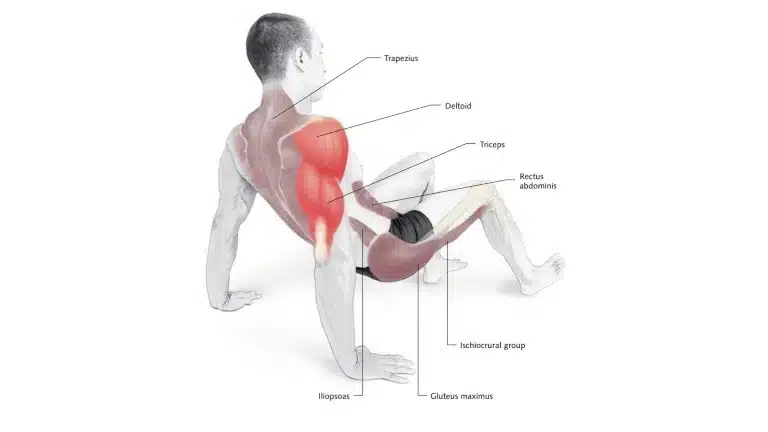
How To Do
- Position your hands and feet so that they are flat on the ground, and you are face up.
- Lift your butt up off the ground by tightening your gluteal muscles.
- Begin “walking” by first moving your hands and then your feet.
- To avoid excessive shoulder strain, move your hands no more than 6 to 8 inches (15 to 20 cm) at a time.
- As a caution, do not let your feet move too fast for your upper body so as not to injure your shoulders.
11. Hindu Push Up
The Hindu push-up, also known as a “Dhand” , is a bodyweight exercise that targets the shoulders, chest, triceps, and core and back muscles.
It is a dynamic exercise that combines elements of yoga and traditional push-ups to create a more challenging shoulder workout.
It provides better muscle strength and endurance. It is a complete exercise that has a compound effect on the body.

How To Do
- Start in a downward dog pose, with your hands shoulder-width apart, your body in a V shape.
- Engage your core, relax the spine and neck, open the shoulders and keep the movement smooth.
- Bend your elbows and lower your chest until it’s just above the floor.
- In a scooping motion, scoop your head upward while arching your lower and upper back and go into cobra pose.
- Return to the starting position, you do not need to reverse back through the sweeping, arching motion.
- Simply push back into the starting position.
12. Inverted Row
The inverted row, also known as the body row, is an efficient bodyweight workout that targets the shoulders and other upper body muscles.
Inverted rows are an effective and safe exercise for strengthening the shoulders, improving stability, and supporting shoulder health
Unlike pull-ups, which primarily target the latissimus dorsi (back muscles), the inverted row emphasizes the middle and lower trapezius and rear delt.
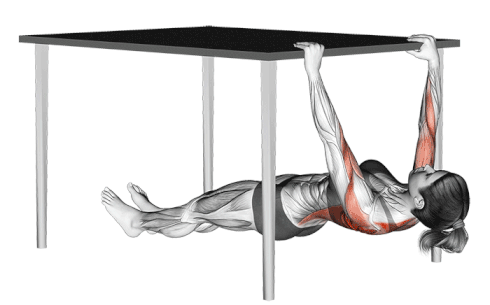
How To Do
- Adjust the height of the chair and bar so that it’s a little higher than arm’s length from the floor.
- Lie under the table with your legs and body straight. And grab the table.
- Do not allow your butt to sag. Flex your tummy, squeeze your butt cheeks, and keep your body stiff from your head to your toe.
- Exhale as you pull your chest up to the bar. Make sure your body and legs stay straight.
- Hold for a count of two and squeeze your back muscles.
- Inhale as you lower your body until your arms and shoulders are fully extended. Repeat.
13. Clapping push-up
In clapping push-ups, an advanced plyometric variation of the standard push-up, you lift your body off the ground explosively with enough force to make your hands clap together before returning to the starting position.
It strengthens the fast-twitch muscle fibers in your shoulders, giving you explosive power that standard push-ups just cannot match.
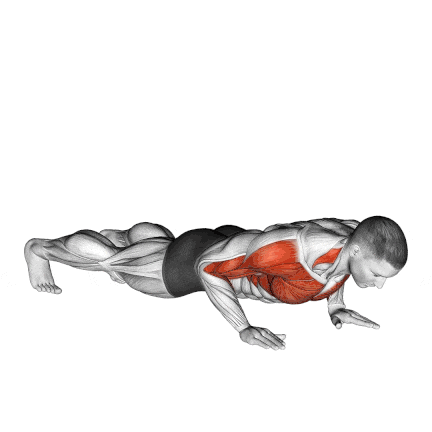
How To Do
- Begin in a traditional push-up position — hands shoulder-width apart, body in a straight line.
- Start to lower your body as if you’re going to do a push-up until your chest is almost touching the floor.
- Reverse the motion by pushing hard through the palms, just as your arms reach full extension, pull your hands up off the floor.
- Rapidly clapping the hands together and placing them back in the original position.
14. Elevated pike push-up
It’s a variation of the Pike Push-Up where the feet are placed on an elevated surface (bench, box, sturdy chair), while the hands remain on the floor.
This creates a steeper body angle, shifting more bodyweight towards the hands and thus increasing the intensity, particularly on the shoulders and triceps. The body forms an inverted “L” or a very steep “V” shape.
It is one of my go-to progressions for clients working toward handstand push-up strength or looking to really dial in shoulder hypertrophy using only their bodyweight.

How To Do
- Find a STURDY elevated surface for your feet – a bench, box, or steps work well. The higher the surface, the harder the exercise.
- Place your hands on the floor, about shoulder-width apart or slightly wider. Fingers spread, pointing generally forward.
- Walk your feet up onto the elevated surface. Aim to get your hips stacked as directly over your shoulders/hands as possible. Your body should form a steep inverted ‘V’ or almost an ‘L’ shape.
- Initiate the movement by bending your elbows, lowering the top of your head towards the floor.
- Elbows should track backward or slightly out to the sides (around 45–60 degrees from your body), NOT flaring straight out to the sides like a standard push-up.
- Drive through your palms, powerfully pressing your body back up to the starting position.
15. Handstand Push Up
The handstand push-up also called the vertical push-up is a type of push-up exercise where the body is positioned in a handstand.
It is an advanced bodyweight exercise that targets the shoulders, as well as the arms and core.
They require a high degree of upper body strength and skill and should be attempted only after proper training and conditioning.
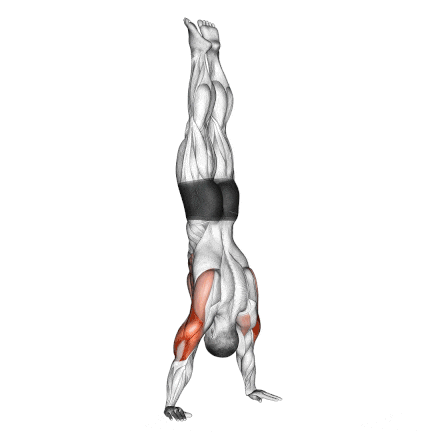
How To Do
- start in a handstand position against a wall, with your hands placed on the ground and your body in a straight line.
- Slowly lower your body down towards the ground by bending your arms, keeping your body in a straight line.
- Push your body back up to the starting position by extending your arms.
- It is important to have a spotter or use a wall for safety and support when attempting this exercise.
Know About Shoulder Muscles
The shoulders comprise several muscles that work together to provide a wide range of motion and stability.
The main muscles of the shoulder are the deltoids, rotator cuff, and trapezius.
Deltoids
In fitness, “shoulder exercises” refers to resistance exercises that target the deltoid muscle.
While the deltoid is technically a single muscle, anatomically speaking it has three distinct sets of muscles fibers and muscle bellies, which are referred to as “heads.
- The anterior deltoid (In front),
- lateral deltoid (at the side), and
- Posterior deltoid (behind),
The deltoids are responsible for shoulder flexion, extension, and abduction.
Rotator cuff
The rotator cuff consists of four small muscles that attach to the shoulder blade and help stabilize the shoulder joint.
The supraspinatus, infraspinatus, teres minor, and subscapularis muscles all make up the rotator cuff.
Trapezius
The trapezius muscle is a large muscle that runs from the base of the skull to the middle of the back and is responsible for shoulder elevation, depression, and rotation.

Beginner Bodyweight Shoulder Workout Plan
For those new to bodyweight exercises, it’s important to start with relatively easy exercises and focus on proper form.
Some good options for beginners include. I, Y, T, W, wall push-ups, knee push-ups, and bird bog Pose.
| Exercise | Sets | Reps/Duration |
|---|---|---|
| Warm-up | – | 5-min light cardio |
| I, Y, T, W | 2-3 | 3-4 reps each |
| Incline Push-ups | 3 | 8-10 reps |
| Side Plank | 3-4 | 10-20 seconds hold |
| Bird Dog | 3 | 8-10 reps |
| Cool-down | – | 5-min stretching |
Intermediate Bodyweight Shoulder Workout Plan
You can progress to more challenging exercises as you build strength and confidence.
Intermediate bodyweight shoulder exercises include regular push-ups, crab walk, and Hindu push-up.
Here is a sample bodyweight shoulder workout plan for intermediates:
| Exercise | Sets | Reps/Duration |
|---|---|---|
| Warm-up | – | 5-min light cardio |
| Plank To Push-up | 3 | 12-15 reps |
| Tabletop Reverse Pike | 3 | 10-20 seconds hold |
| Dips | 3 | 12-15 reps |
| Crab Walk | 3 | 12-15 reps |
| Shoulder Tap Push Up | 3 | 8-12 reps |
| Cool-down | – | 5-min cool-down |
Advanced Workout Plan
For those looking for a more challenging workout, advanced bodyweight shoulder exercises include handstand push-ups, Pike push-ups, and inverted rows.
These exercises require high upper-body strength and skill, so it’s important to progress slowly and focus on proper form.
| Exercise | Sets | Reps/Duration |
|---|---|---|
| Warm-up | – | 5-min cardio warm-up |
| Pike Push Up | 3 | 8-12 reps |
| Handstand Push-ups | 3 | 8-10 reps |
| High Reverse Plank | 3 | 10-20 sec hold |
| Clapping Push-Up | 3 | 8-12 reps |
| Handstand Walk | 3 | – |
| Cool-down | – | 5-min cool-down |
As you progress, you can increase the number of reps and sets and make the exercises more difficult.
Takeaways
These bodyweight shoulder exercises are highly recommended for anyone interested in building a wider shoulder and who wants to gain strength.
It is easy to do and requires no more scientific details and fancy equipment. You should do some of these 15 exercises as part of your workout routine.
Thanks for reading, enjoy your workout!
References
- Dhahbi W, Chaabene H, Chaouachi A, Padulo J, Behm DG, Cochrane J, Burnett A, Chamari K. Kinetic analysis of push-up exercises: a systematic review with practical recommendations. Sports Biomech. 2022 Jan;21(1):1-40.
- Calatayud J, Borreani S, Colado JC, Martín FF, Rogers ME, Behm DG, Andersen LL. Muscle Activation during Push-Ups with Different Suspension Training Systems. J Sports Sci Med. 2014 Sep 1;13(3):502-10. PMID: 25177174; PMCID: PMC4126284.
- Borreani S, Calatayud J, Colado JC, Moya-Nájera D, Triplett NT, Martin F. Muscle activation during push-ups performed under stable and unstable conditions. J Exerc Sci Fit. 2015 Dec;13(2):94-98. doi: 10.1016/j.jesf.2015.07.002. Epub 2015 Sep 2. PMID: 29541105; PMCID: PMC5812863.
- Plummer HA, Plosser SM, Diaz PR, Lobb NJ, Michener LA. Effectiveness of a Shoulder Exercise Program in Division I Collegiate Baseball Players During the Fall Season. Int J Sports Phys Ther. 2022 Feb 1;17(2):247-258. doi: 10.26603/001c.31638. PMID: 35136694; PMCID: PMC8805093.

Manish is a NASM-certified fitness and nutrition coach with over 10 years of experience in weight lifting and fat loss fitness coaching. He specializes in gym-based training and has a lot of knowledge about exercise, lifting technique, biomechanics, and more.
Through “Fit Life Regime,” he generously shares the insights he’s gained over a decade in the field. His goal is to equip others with the knowledge to start their own fitness journey.
